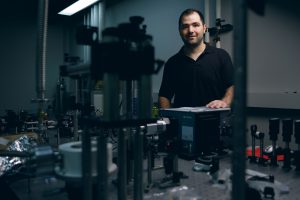TUSCALOOSA, Ala. — The nation’s most prestigious recognition of top-performing young scientists was recently awarded to a biologist and a physicist at The University of Alabama.
The National Science Foundation granted a CAREER Award to Dr. Paulo T. Araujo, UA assistant professor of physics and astronomy, and Dr. Kevin M. Kocot, UA assistant professor in biological sciences and curator of invertebrate zoology in the Alabama Museum of Natural History.
With the funding from the awards, Araujo will understand how to control the optical properties of certain polymers and expand their application toward more sustainable technology while Kocot will use cutting-edge techniques to speed up identification of new species of a group of worm-like mollusks while also training the next generation of scientists studying invertebrates.

The Faculty Early Career Development, or CAREER, Program is a Foundation-wide activity that offers the NSF’s most prestigious awards in support of early-career faculty who have the potential to serve as academic role models in research and education and to lead advances in the mission of their department or organization.
At UA, 29 current faculty members have received NSF CAREER Awards in disciplines ranging from nanoscience and engineering to biological sciences.
Araujo’s $600,000 grant will help his lab investigate how a type of polymer, or repeating chains of molecules, interact with light with the goal of tuning polymers to behave as designed.
“Every time you change the properties of the polymer, you are changing the ways it behaves when it interacts with light,” he said. “By the end of the project we hope to have a complete understanding of these interactions and how to manipulate them.”
Their discoveries could have important implications for the design and control of polymers used in a wide variety of emerging technologies, including light-emitting diodes and solar energy conversion applications. Tunable polymers could be used in electronic devices to reduce reliability on traditional materials, possibly leading to more efficient, less expensive technologies that are more sustainable than using non-renewable materials.

“Polymers are everywhere already, but future technologies will need them even more,” Araujo said. “It’s urgent to use materials that we can actually control and synthesize so they will work in different environments and different types of interactions.”
With his $1.2M grant, Kocot will sample off the coast of Antarctica during two expeditions over the next four years to find new species of aplacophorans and use advanced imaging and DNA sequencing techniques to identify and classify them.
Aplacophorans are a group of worm-like mollusks with calcium carbonate scales or spines that are diverse and ecologically important in the deep sea and polar regions, but very few researchers study them. Kocot previously showed they lost their shells through evolution, and are not, as previously thought, a primitive group that never had a shell.
Kocot and his students aim to understand the diversity of this group and its evolution.
“If we don’t know what’s down there, we can’t know what we’re losing if there is some sort of environmental disaster,” he said. “We have to continue to explore the world.”
The research will help the young scientists in Kocot’s lab learn new techniques in genomics and imaging of the animals.
“All the skills the students will learn won’t just apply to this one, specific question that we are asking right now, but, hopefully, transfer to broad fields,” he said.
Contact
Adam Jones, UA communications, 205-348-4328, adam.jones@ua.edu
